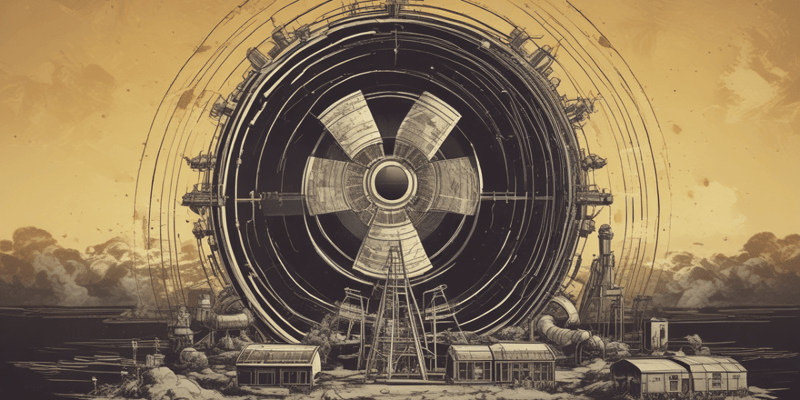12 Questions
Which process involves the emission of high-energy photons to reduce excess energy in the nucleus?
Nuclear decay
What is emitted from an unstable nucleus during alpha decay?
Alpha particle
Nuclear fission is the process by which the nucleus of an atom...
Splits into two or more smaller nuclei
What type of decay involves the transformation of a neutron into a proton or vice versa?
Beta decay
Which nuclear process releases a tremendous amount of energy in the form of kinetic energy and gamma radiation?
Nuclear fission
In nuclear fusion, nuclei...
Combine to form a heavier nucleus
What drives the process of fission in nuclei?
Absorption of neutrons
Which heavy elements are particularly prone to fission?
Uranium and Plutonium
In nuclear fusion, what is the primary form of energy released?
Kinetic Energy
What is the main difference between fusion and fission reactions?
Fusion releases more energy than fission.
Which process involves heavy nuclei splitting into lighter nuclei?
Nuclear Fission
What fundamental processes provide a foundation for understanding nuclear physics?
Nuclear Decay, Fission, Reactions, and Fusion
Study Notes
Nuclei: Exploring Decay, Fission, Reactions, and Fusion
Atoms are the fundamental building blocks of our universe, and at the heart of each atom lies a central structure called the nucleus. The nucleus is composed of protons and neutrons, and it plays a pivotal role in various nuclear processes. In this article, we'll explore nuclear decay, fission, reactions, and fusion—all of which pertain to the fascinating behavior of nuclei.
Nuclear Decay
Nuclear decay, also known as radioactive decay, is the process where an unstable atomic nucleus transforms into a more stable one. This transformation is achieved by the emission of particles such as alpha, beta, or gamma particles, or the conversion of one element into another through a process called beta decay.
Alpha decay involves the emission of an alpha particle (consisting of two protons and two neutrons) from the unstable nucleus. Beta decay refers to the transformation of a neutron into a proton or vice versa, accompanied by the emission of an electron (beta particle) or its antiparticle (positron). Gamma decay is the emission of high-energy photons, which helps to reduce the excess energy in the nucleus.
Nuclear Fission
Nuclear fission is the process by which the nucleus of an atom splits into two or more smaller nuclei, releasing a tremendous amount of energy in the form of kinetic energy and gamma radiation. Fission is primarily driven by the capture of neutrons by the nucleus, which can cause the nucleus to become unstable.
Heavy elements, such as uranium and plutonium, are particularly prone to fission. When uranium-235 or plutonium-239 captures a neutron, it can transform into an unstable nucleus, which then breaks apart into two or more smaller nuclei, releasing several neutrons in the process. These secondary neutrons can cause further fission reactions, resulting in an exponential release of energy.
Nuclear Reactions
Nuclear reactions are processes in which nuclei react with each other, or with other particles, to form new nuclei. Nuclear reactions can be categorized into two main types: fusion and fission reactions. Fusion reactions occur when light nuclei combine to form heavier nuclei, such as the fusion of hydrogen isotopes to produce helium. Fission reactions, on the other hand, occur when heavy nuclei split into lighter nuclei, releasing a vast amount of energy in the process.
Nuclear Fusion
Nuclear fusion is the process by which two light atomic nuclei combine to form a heavier nucleus, releasing a tremendous amount of energy in the form of kinetic energy. Fusion reactions primarily occur in stars, such as the Sun, where protons combine to form nuclei of helium-4.
On Earth, fusion reactions are harnessed in processes like inertial confinement fusion (ICF) and magnetic confinement fusion (MCF). ICF involves the use of lasers to compress and heat a fuel pellet containing isotopes of hydrogen until they fuse, while MCF employs magnetic fields to trap and heat the fuel.
Understanding Nuclear Processes
The behavior of nuclei and their interactions with one another underlie the complex and fascinating world of nuclear physics. Nuclear decay, fission, reactions, and fusion are all intricately intertwined processes that provide a solid foundation for understanding the inner workings of the atom and the universe as a whole.
By studying these processes, we can gain a deeper appreciation of the vast amount of energy available to us as well as the potential challenges and benefits that come with harnessing this energy. With ongoing research and innovation, we can continue to explore new and exciting applications of nuclear science, from the development of clean and sustainable energy sources to the advancement of medical technologies that can detect and treat diseases.
Explore the fundamental processes of nuclear decay, fission, reactions, and fusion that govern the behavior of atomic nuclei. Learn about radioactive decay, nuclear fission, fusion reactions, and the intricate interactions of nuclei in this in-depth exploration.
Make Your Own Quizzes and Flashcards
Convert your notes into interactive study material.




